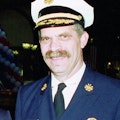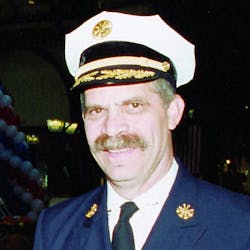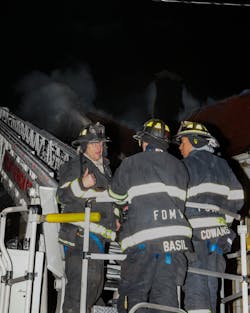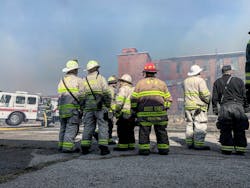“Dispatch, from Engine 17! We are on location at 3700 Andrews Drive.”
The report was hurried and being shouted.
“We have an industrial building that is heavily involved in fire on the first floor. Strike out a second alarm.”
“Engine 17, from dispatch. What is the building size? Has the building been evacuated? Do you have orders for the incoming companies?”
There was no reply from Engine 17.
“Battalion 4 is on location at 3700 Andrews Drive. We have a three-story industrial building 50 feet by 100 feet. There is fire showing on the first floor and medium-to-heavy smoke on all floors. Companies are leading off with 2½-inch hoselines. Truck companies are coordinating ventilation with the interior companies. We have been advised that all occupants have been evacuated. Have the second alarm proceed to staging at 36th & Andrews Drive. Battalion 4 will be Andrews Command.”
On the tactical channel, the chief contacted Engine 17, and he requested a report of interior conditions. Engine 17’s officer excitedly reported fire in the first floor that they were attacking with their 2½-inch hoseline.
Command then had to ask additional questions to clarify the size of the fire, its approximate location, whether it was contained or was spreading and whether Engine 17 was in the process of making a primary search of the first floor.
Command’s calm demeanor seemed to have a positive effect on Engine 17’s officer, and the officer proceeded to give the information that was requested. The chief quickly addressed the problems by assigning units to conduct a primary search and to perform ventilation. The aggressive interior attack enabled a quick knockdown of the fire, and the closed fire doors allowed containment of the fire. The chief methodically received progress reports from the other units, and the incident was brought under control.
The officer of Engine 17 was a new lieutenant. Afterward, he explained how he initially felt overwhelmed with the amount of fire that showed and the fact that people still were evacuating from the building. The chief praised the lieutenant for immediately requesting the second alarm and the initial attack in containing the fire. The chief emphasized that the arrival of a chief officer might not occur as quickly as it did at this fire and the importance of the first-arriving officer to remain calm and to determine the scope of the entire incident. This includes giving a comprehensive report and then assigning responding units to address the problems that were found and to assist the initial company in accomplishing their assignment.What is command presence?
Command presence, or command leadership, is described as positive traits that are easily recognizable, yet they can be difficult to achieve. A fire officer who displays command presence at an emergency scene is admired for the following traits:
- Competence—He/she recognizes firefighters’ abilities and gives assignments to fully utilize those abilities;
- Composed—Although problems constantly arise, he/she never seems to get flustered; each situation is handled, and the officer remains prepared to solve the next problem;
- Cool under pressure—While others seem tired and worn out, the officer is unruffled and patient and seems to thrive on tense situations; he/she never seems to sweat;
- Dignified—There is a sense of dignity that the officer seems to exude; this is very difficult to describe but easy to identify;
- Decisiveness—There is no wavering about decision-making; the officer is determined and forceful about what needs to be accomplished and by whom;
- In charge—There never is a doubt who is the boss (command is a demanding and autocratic position; the critical nature of the emergency scene doesn’t allow decisions to be made by committee); everything about the officer smacks of responsibility and leadership;
- A problem-solver—He/she can break problems into manageable parts and mete out appropriate assignments to solve the problems; as situations change, so does the officer’s orders to meet the anticipated changes;
- Self-confidence—The officer is poised, assured, certain, firm and convinced that he/she can handle any situation—but not overconfident or cocky, which would run the risk that something would be overlooked; and
- Goals-oriented—The officer can shift into a higher gear to achieve goals yet be constantly protective of the safety of firefighters.
Lack of command presence
The opposite of a fire officer who has command presence is the officer who runs around an incident scene and talks loudly, shouts orders, uses profanity to enforce the importance of a task and/or exhibits dysfunctional behavior. The latter’s actions accomplish little while often interfering with sound operations that are initiated by subordinate officers.
A problem with running at an incident scene is that it seems that the human brain tries to react at the same rate of speed that the feet are moving. Orders that are shouted aren’t thought out and often are faulty. Shouting denotes an unsolvable problem and tends to foster confusion. Shouting can instill fear in those who are receiving orders—fear of the person and fear of the consequences of the situation. It becomes contagious and can cause those who are receiving orders to shout, too. Fire officers who can’t control themselves can’t expect to control others. Furthermore, how can a firefighter admire and respect an officer who destroys a firefighter’s personal esteem through the officer’s uncontrollable actions?
Incident scenes must be managed in a professional manner. We didn’t cause the problem. We were called to solve it. A fire officer who acts in an irresponsible way not only loses the respect and confidence of the firefighters but causes citizens to question their professionalism.
Developing command presence
Command presence comes from confidence, which can be developed through training, education and experience. These factors play an important role in preparing a fire officer. When a fire officer is prepared for a situation, the situation doesn’t come as a surprise or an emergency. It becomes part of the incident-scene routine. The more knowledge that one possesses, the easier that it becomes to make the correct decision. When fear of an emergency is removed, the stress that might otherwise impact the decision-maker is removed, too. The actions required are easier to identify, and incident scenes are handled in a professional manner.
Preparing for an incident can start when a fire officer performs routine inspections on buildings. He/she should view structures with an eye toward the type of problems that can develop if a fire occurs. The officer should imagine where a fire is most likely to start and how it can spread. The officer should try to determine what the fire department can do to mitigate the anticipated problems. Considerations should include the 13 points of size-up, particularly the time—time of day, time of week and time of year. The effect of time on an incident includes everything from delayed discovery when a facility is closed to a fire department having a limited response of personnel (because of reduced staffing in a career department or a limited number of available volunteers in combination or volunteer departments).
Track and field athletes are taught to envision each step during their event, whether during a high jump, throwing a discus or running hurdles, for example.
Some sports require studying of videotape and anticipating the actions and reactions of opponents. In baseball, a batter can discover the tendencies of a pitcher to throw a type of pitch in specific situations, or a pitcher might find a batter’s weakness against a certain pitch or that a batter rarely swings at the first pitch. In football, knowing how a defensive player might react to various plays could give an offensive team an advantage.
Although firefighting is certainly not a game, we are professionals and must take advantage of all training opportunities.
Personal training
To enhance one’s command presence, the fire officer should do a self-evaluation. What image do others see in him/her at emergency scenes? Does he/she project a confident demeanor? Does the officer consistently use a methodical and professional way of handling an incident?
To improve, a fire officer should observe another fire officer who has command presence, someone who he/she respects and admires, and then style him/herself after that person. What makes that officer stand out? Copy his/her actions. Ask the officer how he/she does certain things. (Flattery is the ultimate compliment.)
Realize that we can learn something from everyone. It might be positive traits that we want to emulate or negative actions that we hope to avoid. Personal training of a fire officer to develop command presence involves how one’s actions are perceived by those who are commanded. Does your voice quaver when you give an order, or is it crisp, concise and self-assured? Is an air of confidence displayed?
If your find that your vocal delivery isn’t forceful, you can practice giving orders during simulated fires. This practice can reinforce your confidence and will carry over to the incident scene where reports can be given with authority and conviction.
Case studies
The fire service, in general, operates well when dealing with routine types of fires in residential buildings, house trailers or vehicles. We gain proficiency through repetition. Fires in other types of structures and target hazards (high rises, refineries, churches, nursing homes, schools, prisons, hospitals, etc.) become a challenge because of their infrequency, and these incidents can overwhelm a fire officer. Since training develops confidence, a fire officer can enhance him/herself by reviewing case studies of fires from other jurisdictions. Many lessons can be learned by reading fire journals or by investigating reports of incidents. The case studies can be useful in determining potential problems that could occur in similar fires and allow a fire officer to become decisive by removing the fear of emergencies that are created by unknown situations.
The National Institute for Occupational Safety and Health, through the Fire Fighter Fatality Investigation and Prevention Program, conducts investigations of firefighter line-of-duty deaths to formulate recommendations for preventing future injuries and deaths. The program doesn’t seek to determine fault or place blame on fire departments or individual firefighters but to learn from tragic events and to prevent similar events in the future. The progressive fire officer who studies these reports can prepare him/herself and train firefighters for addressing these types of emergencies, including alternative strategies, such as withdrawing personnel to a safe haven. The goal is to create a routine operation out of a previous deadly situation.
Serious business
There is no room in firefighting for displaying anything less than a positive attitude. Members can’t be allowed to freelance or to take actions into their own hands. A total team effort must be driven by accomplishing the needed and intended tasks. Fire officers must ensure that each member of their company works toward these goals.
Accomplishing these tasks is enhanced when a fire officer displays command presence.
About the Author

James P. Smith
JAMES P. SMITH, was a Firehouse contributing editor and a retired deputy chief of the Philadelphia Fire Department. He is an adjunct instructor at the National Fire Academy and the author of the fourth edition of the book "Strategic and Tactical Considerations on the Fireground," which was published by Brady/Pearson.


